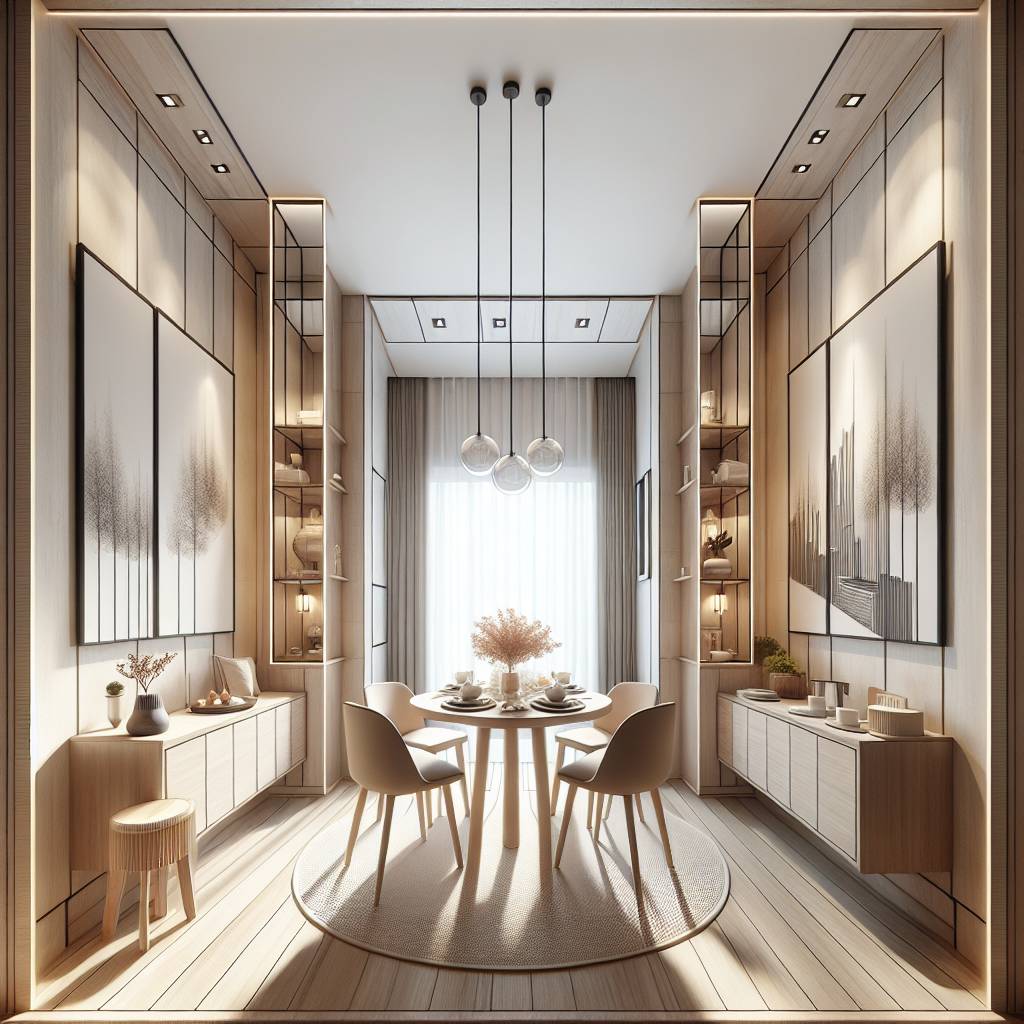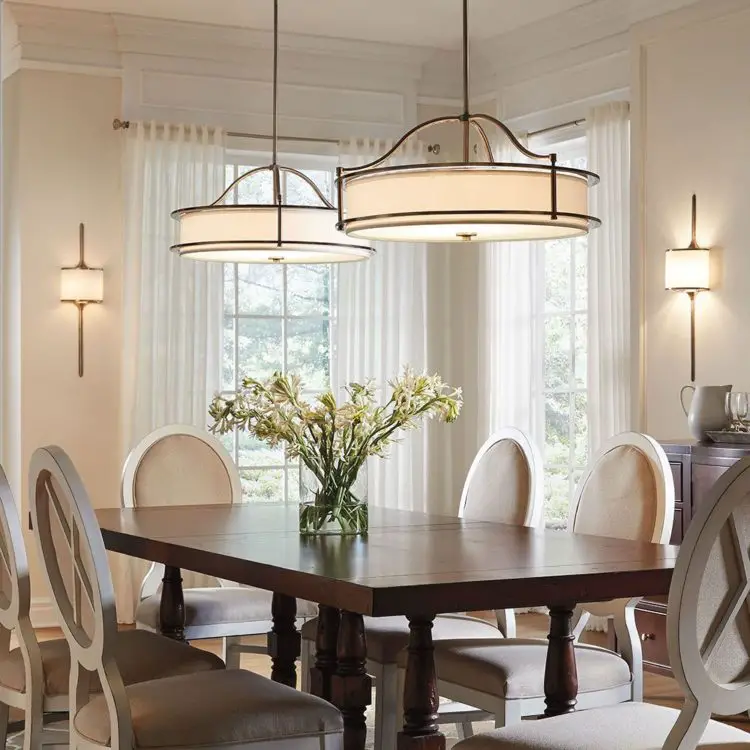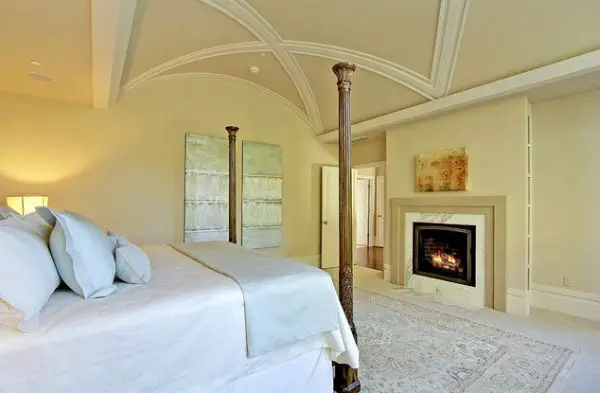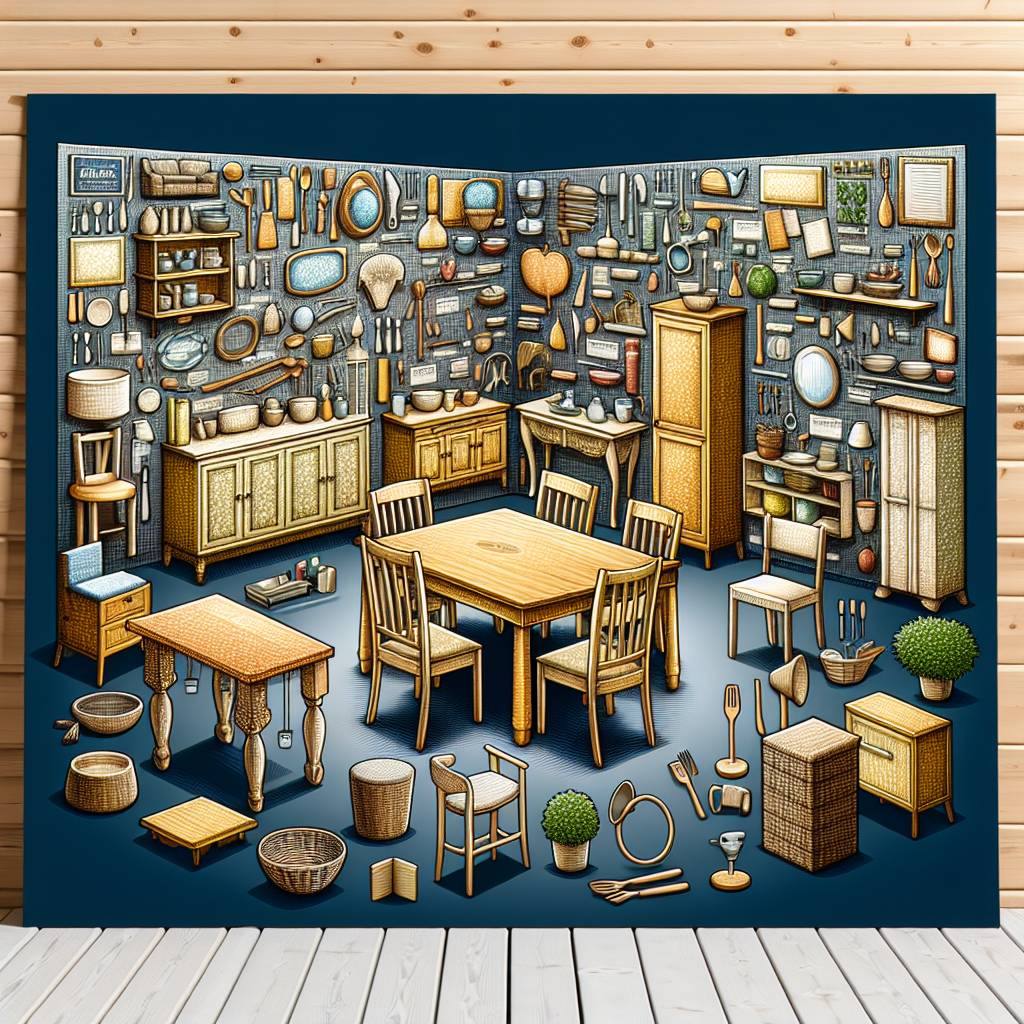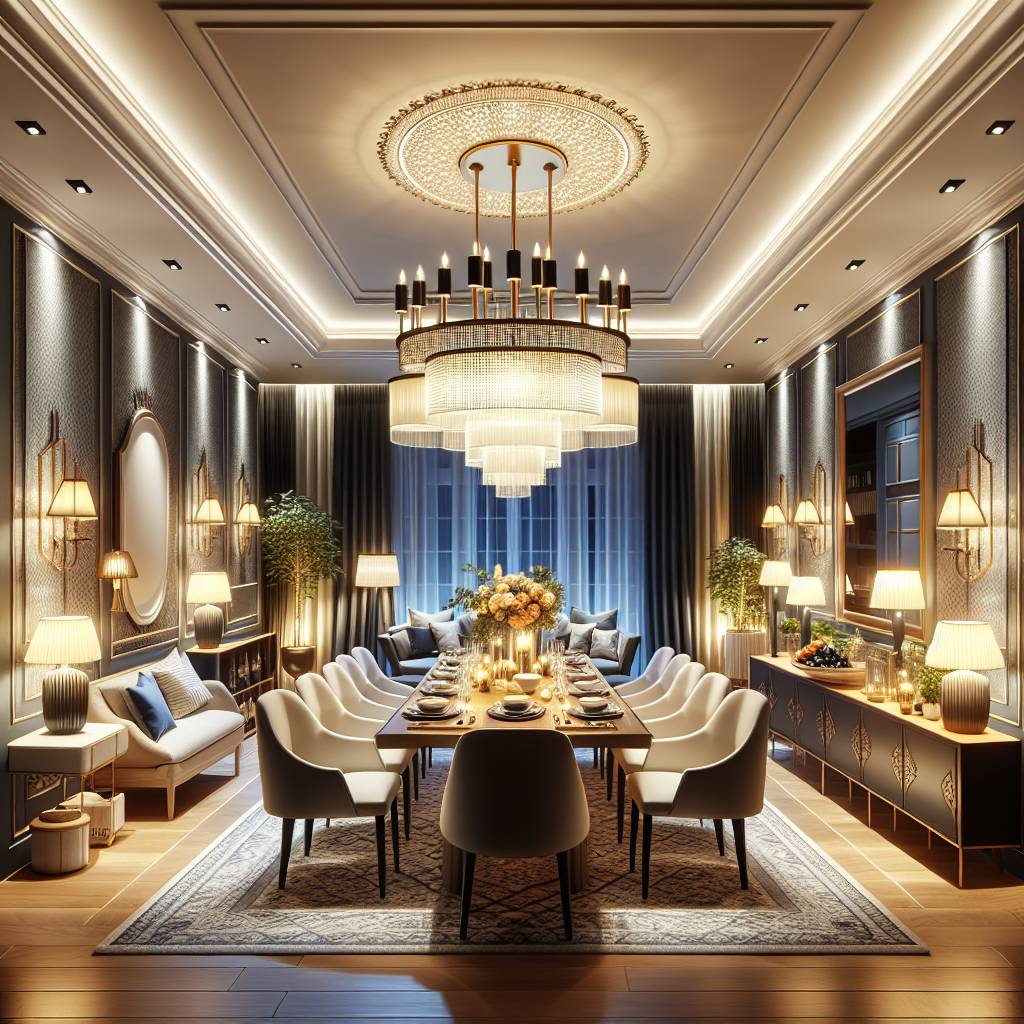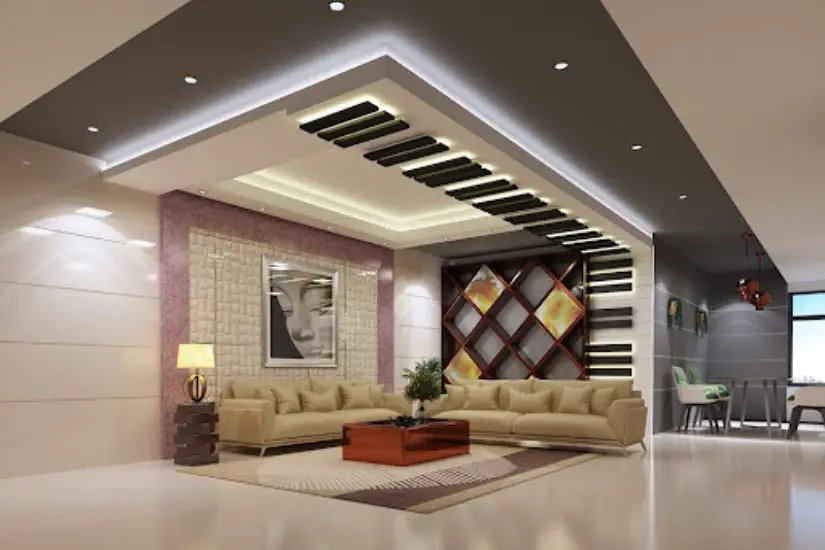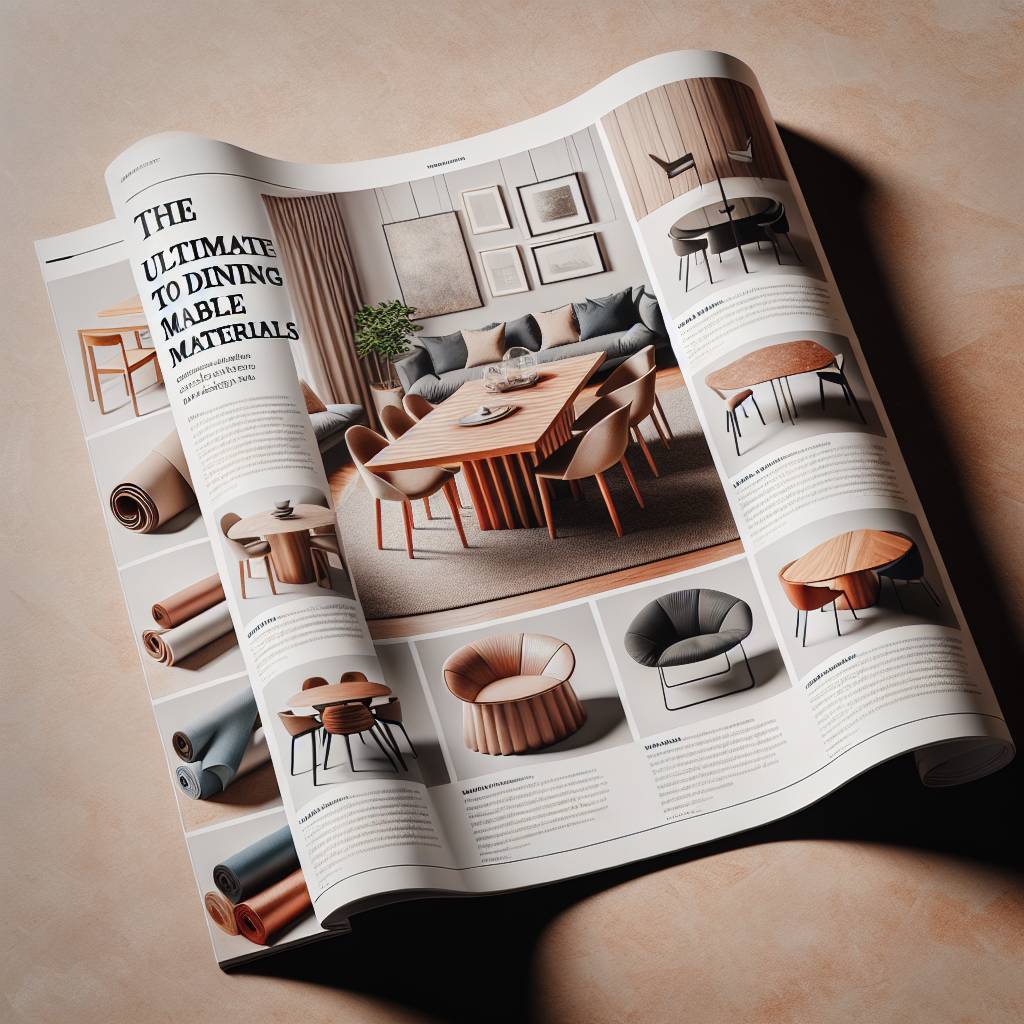Want to transform your small dining space into a roomy, inviting area with upholstered chairs? We’ve got you covered! Small dining areas can often feel cramped and limited, but with the right decor tips, you can create an illusion of spaciousness. In this post, we’ll delve into practical and creative strategies to make your cozy dining nook appear larger than life.
From strategic furniture placement to clever color choices and lighting tricks, we’ll explore actionable advice that doesn’t require knocking down walls. Whether it’s maximizing natural light or utilizing multifunctional pieces like chairs, these decorating tips will help you revamp your small dining space without compromising on style or comfort. Say goodbye to the claustrophobic vibes and hello to an airy ambiance perfect for entertaining friends and family!
Key Takeaways
- Use light and neutral colors to create an illusion of space and maximize natural light, making the dining area feel larger.
- Opt for a round or oval dining table to create a spacious feel and improve traffic flow in small dining spaces.
- Incorporate vertical storage solutions and built-in seating to make the most of the available space and reduce clutter.
- Choose sleek furniture and open-backed chairs to maintain an airy and unobstructed look in the dining area.
- Integrate mirrors and strategic lighting to amplify natural light and create the perception of a larger dining space.
- Select a rug size that defines the dining area without overwhelming the space, enhancing the visual appeal while maintaining a sense of spaciousness.
Creating Illusions of Space with Color and Light
Light, Neutral Colors
Using light, neutral colors is a game-changer. These hues create an airy and open feel, making the dining area, kitchen, curtains, and light fixture appear more spacious in the small space. Shades like soft whites, creams, and light grays can visually expand the room by reflecting natural or artificial light.
For example:
- Opting for a pale blue or blush pink color scheme on the walls can give the illusion of depth and make the space seem larger.
- A combination of white walls with pastel-colored furniture can contribute to creating an expansive atmosphere in a small dining area.
Incorporating Mirrors
In addition to utilizing light colors, incorporating mirrors into the decor can significantly enhance the perceived size of a small dining space. Mirrors have this magical ability to reflect both natural and artificial light throughout the room, which creates an optical illusion of depth and enhances the look of the decorating. Placing large mirrors strategically opposite windows or sources of light amplifies this effect even further.
For instance:
- Hanging a mirror directly across from a window not only reflects outdoor scenery but also gives off an impression that there’s more space behind it.
- Using mirrored furniture pieces such as cabinets or buffets adds another layer of visual depth while serving as functional storage solutions.
Strategic Lighting Fixtures
Strategic lighting fixtures play a pivotal role in enhancing the perception of space within compact dining areas. By strategically placing overhead lights or wall sconces around the room, you can eliminate dark corners and shadows that tend to make spaces feel smaller than they are. Choosing lighting fixtures with adjustable brightness levels allows you to control how much illumination your dining area receives based on different occasions.
To illustrate:
- Pendant lights suspended above the dining table not only provide focused illumination for meals but also draw attention upward, giving an impression of heightened ceiling height.
- Wall-mounted sconces positioned at eye level emit ambient lighting that helps create an inviting atmosphere without encroaching on valuable floor space.
Choosing the Right Dining Table for Small Areas
Maximize Space and Flow
Choosing the right table is crucial. Opting for a round or oval dining table can maximize space and promote better flow in the area. These shapes eliminate sharp corners, allowing people to move around more freely without bumping into edges or corners.
A round or oval table and chairs also create a sense of harmony and inclusivity, making everyone feel connected during meals. This shape is ideal for creating an inviting atmosphere in a small dining nook. These tables often have a smaller footprint compared to rectangular ones, making them perfect choices for small rooms.
Flexibility with Drop-Leaf or Extendable Tables
In small dining areas where space is at a premium, consider investing in a drop-leaf or extendable dining table. These types of tables look offer flexibility by providing extra seating when needed while maintaining a compact size when not in use.
For instance, if you frequently entertain guests but have limited space on regular days, an extendable table allows you to adjust its size based on your needs. When not extended, it can serve as an intimate setting for everyday meals but easily transforms into a larger surface during gatherings, giving it a versatile look.
Create Visual Illusion with Glass or Acrylic Tables
To create the illusion of openness and airiness in small dining spaces, consider using glass or acrylic tables to achieve a modern look. The transparent nature of these materials allows light to pass through them unobstructed, visually expanding the room’s perceived size.
Incorporating Circular Tables for a Spacious Feel
Open and Inviting Space
Circular tables look an excellent choice for making small dining spaces appear larger. The absence of sharp corners creates a more open and inviting atmosphere, eliminating the visual barrier created by square or rectangular tables. This gives the impression of enough room in the area, making it seem less cramped.
Pairing Dining Room Furniture for Small Spaces, a circular table with minimalist chairs further enhances this effect. By keeping the seating light and unobtrusive, you maintain an airy ambiance that contributes to the look of spaciousness. Using a pedestal table base instead of legs can also help create a sense of openness as it allows for more legroom and reduces visual clutter on the floor.
Encouraging Social Interaction
In small dining areas, circular tables look promote better social interaction compared to other shapes like square or rectangle. The absence of defined sides encourages everyone at the table to engage in conversation without anyone feeling isolated at a corner or edge. This layout fosters an inclusive environment where all diners feel involved and connected during meals.
Moreover, circular tables positioned centrally within the space allow easy access from all sides, ensuring that every seat feels equally important and accessible. This arrangement not only makes the room feel more welcoming but also maximizes its footprint, utilizing space efficiently without creating bottlenecks or awkward dead zones.
Enhancing Vertical Space and Built-In Seating Solutions
Wall-Mounted Storage
Maximizing vertical space is crucial in small dining areas. By utilizing wall-mounted shelves or cabinets, you can free up valuable floor space. These storage solutions not only provide a practical way to keep your dining area clutter-free but also create an illusion of spaciousness. Consider sleek, floating shelves to display decorative items while maintaining an airy ambiance.
Another advantage of wall-mounted storage is the flexibility it offers. You can customize the shelving units to fit your specific needs, whether it’s for storing dinnerware, glassware, or even small indoor plants that add a touch of greenery without taking up precious floor space.
Built-In Seating with Hidden Storage
Integrating banquette seating or built-in benches into your dining area can be a game-changer for creating an open and uncluttered atmosphere. Not only does this type of seating maximize available space by hugging the walls, but it also provides hidden storage underneath the seats—perfect for stowing away extra linens, seasonal decorations, or seldom-used kitchen gadgets.
A banquette bench or window seat not only serves as functional seating but also adds visual interest to the room. Pairing it with a circular table from our previous section creates a cozy and inviting nook where family and guests can gather comfortably.
Pendant Lights and Chandeliers
When dealing with limited ceiling height in small dining spaces, strategic lighting choices are essential for creating an expansive feel. Hanging pendant lights or chandeliers above the dining table draws the eye upward, emphasizing verticality and adding an element of grandeur to the room.
Opt for slimline fixtures that don’t overwhelm the space visually while still providing ample illumination during meals. By directing attention upwards towards these elegant light sources rather than focusing on horizontal constraints, you effortlessly elevate the perceived height of your dining area.
Utilizing Sleek Furniture and Open-Backed Chairs
Slim Profile Furniture
Choosing furniture with slim profiles is crucial. Opt for pieces that are visually lightweight, such as a narrow-legged table or a slender buffet. These will help prevent the space from feeling cramped and overwhelming. By selecting sleek furniture, you can create an illusion of spaciousness in the dining area.
Furniture with legs instead of bulky bases also contributes to opening up the room. For instance, a dining table with exposed legs allows light to pass through, making the area appear more expansive. Similarly, opting for a console or sideboard with tapered legs rather than solid sides helps maintain an airy atmosphere in the small dining space.
Open-Backed Chairs
In addition to selecting slim-profiled furniture, incorporating open-backed chairs is essential for creating an illusion of space in a compact dining area. The open design of these chairs enables light to permeate through them, resulting in an inviting and airy ambiance within the room. This not only adds visual interest but also prevents the seating arrangement from appearing heavy and dense.
Maximizing Natural Light with Mirrors and Strategic Lighting
Reflecting Natural Light
Placing mirrors strategically in small dining spaces can create the illusion of a larger area by reflecting natural light throughout the room. For instance, positioning a mirror directly across from a window allows it to bounce sunlight around, brightening up the entire space. This simple trick not only maximizes natural light but also adds depth and dimension to the room.
Using sheer curtains or blinds that allow maximum sunlight penetration is essential for enhancing the effect of mirrors. By allowing as much natural light as possible into the room, these window treatments complement the reflective properties of mirrors, making the space feel more open and airy.
Strategic Lighting Installation
In addition to leveraging natural light through mirrors and window treatments, installing strategic lighting fixtures is crucial for creating an illusion of spaciousness in small dining areas. Recessed lighting or track lighting are excellent choices for evenly illuminating the dining space without taking up precious real estate on walls or ceilings.
By incorporating recessed lights or track lights above the dining table, you can ensure that every corner of the room is well-lit without overwhelming it with bulky light fixtures. These types of lighting create an even distribution of light throughout the space, eliminating harsh shadows and making it feel more expansive.
When choosing lighting, consider opting for pendant lights that serve as both functional fixtures and decorative elements. A well-placed pendant light can draw attention upward towards high ceilings if present or act as a focal point in lieu of extensive wall decor or wallpaper.
Selecting the Ideal Rug Size to Define the Dining Area
Choosing the Right Rug Size
Selecting the ideal rug size is crucial. The rug should be large enough for all chairs to comfortably fit on when pulled out from the table. This ensures that there is no dragging or catching of chair legs, which can make a space feel cramped and cluttered.
It’s essential to ensure that the chosen area rug extends beyond the dining table. This extension visually defines the dining area within an open-plan living area, creating a clear separation between different zones in a room. By defining this specific space with a rug, you can give the impression of a larger and more organized area.
Opting for Light Colors or Subtle Patterns
Opting for an area rug with light colors or subtle patterns contributes significantly to creating a sense of spaciousness in small dining areas. Light-colored rugs reflect natural and artificial light, brightening up the room and making it feel more expansive. On top of that, rugs with subtle patterns provide visual interest without overwhelming or crowding the space.
In addition to maximizing natural light through mirrors and strategic lighting as discussed earlier, choosing an appropriately sized and designed area rug helps create an illusion of openness in small dining spaces. For instance, imagine placing a large cream-colored rug under your compact dining set; this would instantly give off an airy vibe while clearly delineating your eating area within your living space.
Implementing Clever Storage to Minimize Clutter
Floating Shelves and Wall-Mounted Cabinets
Maximizing storage in a small dining space can significantly contribute to creating an illusion of spaciousness. Clutter is the enemy of a small area, so using floating shelves or wall-mounted cabinets can be game-changers. These options provide additional storage without occupying valuable floor space, making the room feel more open and less cramped. For instance, installing floating shelves above the dining table not only offers a place for displaying decorative items but also keeps the tabletop clear, enhancing the sense of openness.
Investing in furniture pieces with built-in storage compartments is another effective strategy for combating clutter and maximizing available space in a small dining area. Sideboards or buffets with drawers and cabinets offer convenient storage solutions while serving as stylish additions to the room’s decor. By utilizing these multifunctional furniture pieces, you can keep essential items close at hand yet neatly tucked away, preventing visual chaos that often accompanies limited spaces.
Decorative Baskets or Bins
To maintain an organized and visually appealing dining space, incorporating decorative baskets or bins into your decor scheme can work wonders. Small items such as napkins, placemats, or extra cutlery tend to contribute to clutter, especially in compact areas where every inch counts. Utilizing stylish baskets or bins allows you to keep these necessities close by while keeping them out of sight when not in use.
Integrating Multi-Purpose Furniture for Added Functionality
Dual-Function Dining Table
Integrating multi-purpose furniture is essential. A dual-function dining table can be a game-changer in optimizing space. Look for a table that can easily transform into a workspace or serving area when needed. This versatility ensures that the dining area doesn’t remain underutilized during non-meal times, adding functionality without consuming extra space.
Consider investing in a dining table with foldable or drop-leaf sides, allowing you to expand or shrink the surface as per your requirements. This adaptability enables you to maximize space while accommodating different needs, whether it’s hosting dinner parties or working on projects without feeling cramped.
Storage-Ottoman Seating
In small dining areas, seating often poses a challenge due to limited space. To address this issue and create an illusion of spaciousness, consider incorporating benches or ottomans with hidden storage capabilities. These pieces not only serve as comfortable seating but also offer valuable storage solutions for items like linens, placemats, or seasonal decor.
Opting for storage ottomans that double as seats provides a practical solution by minimizing clutter while maximizing functionality within the compact setting of a small dining area. By seamlessly blending seating and storage elements into one piece of furniture, you can achieve both comfort and organization without sacrificing precious floor space.
Versatile Bar Cart
Another ingenious way to optimize small dining spaces is by introducing versatile furniture such as a bar cart. This mobile beverage station not only adds an element of sophistication but also serves as an efficient storage solution in tight quarters. With its ability to store glassware, bottles, and other entertaining essentials while being easily movable around the room, it offers flexibility and convenience.
Final Remarks
So, there you have it – a plethora of tips and tricks to transform your small dining space into a roomy oasis. By playing with color, light, furniture choices, and strategic design, you can create an illusion of spaciousness that will leave your guests in awe. Remember, it’s not just about making the most of what you have; it’s about creating an environment that feels open and inviting. With the right techniques, even the coziest dining nook can feel like a grand banquet hall. Now, go ahead and put these ideas into action, and watch as your small dining space expands before your eyes!
Frequently Asked Questions
FAQ
How can I create the illusion of space with color and light?
To create the illusion of space in a small dining area, use light, cool colors to make the room feel more open. Incorporate ample natural light and strategic lighting to brighten up the space and make it appear larger.
What type of dining table is best for small areas?
Opt for a round or oval dining table as they take up less visual space compared to rectangular tables. This creates a more spacious feel in your small dining area while accommodating seating.
How can I enhance vertical space in my small dining area?
You can enhance vertical space by installing shelves or cabinets above eye level to maximize storage without taking up valuable floor space. Consider built-in seating solutions such as benches that tuck neatly under the table.
What types of furniture are best for making a small dining area look bigger?
Choose sleek furniture with clean lines and open-backed chairs to maintain an airy feel. Opting for transparent materials like glass or lucite can also give the impression of more space.
How do I maximize natural light in my small dining area?
Maximize natural light by strategically placing mirrors on walls opposite windows to reflect light throughout the room. Consider using sheer window treatments that allow plenty of sunlight into the space.
